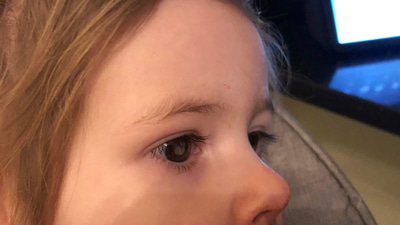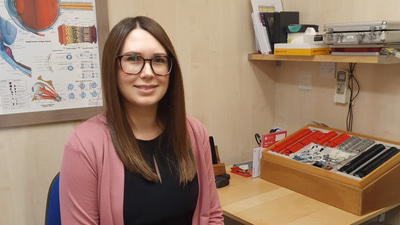- OT
- Life in practice
- Practitioner stories
- “I was shocked to see what I suspected to be a retinoblastoma”
An optometrist saved my life
“I was shocked to see what I suspected to be a retinoblastoma”
Optometrist, Laura Leafe, and relative, Ewelina Skwarlo, on the photograph that led to an urgent appointment and referral for Skwarlo’s daughter

26 February 2023
Had Olivia been experiencing any symptoms prior to the appointment? How had this affected her in day-to-day life?
Ewelina Skwarlo (ES), mum to Olivia: It was February 2022 when Olivia was diagnosed with retinoblastoma – just after her second birthday.At the time, Olivia was not experiencing any symptoms. One day when she was watching TV, I noticed a strange glare in her right eye. I was observing her eye from different angles, as the glare was not easily visible. Oliver (Olivia’s Dad) was away for few days, so I decided to take few photos when the glare was more visible to send to him.
I did not think it was anything serious, but my instinct was telling me to check what it was. I decided to send the photos to Olivia’s auntie, Laura, who is an optometrist, and consult her about it.
In the meantime I started to search on Google: ‘glare and reflection’ in the eye where I came across retinoblastoma. I started to panic that it may be this. I had never heard about retinoblastoma before.
As Olivia was two years old at the time, we did not notice anything else, just a glare when looking deeply in her eye at a certain angle. When we were told that she cannot see in her right eye we were surprised, as it was not noticeable at all.
What did the optometrist find, and how did they explain the next steps to you?

When the examination was completed, Laura confirmed the chance it could be retinoblastoma, and said that she would refer us to hospital as soon as possible. She did not say much more as she knew I was doing research about it. As Laura is our family, she knew it was hard moment for us all, and so we went back home knowing we could discuss it later.
Can you describe how you felt during the referral?
ES: I remember that before the examination I kept thinking: surely it will be nothing serious. But we needed to confirm this.After Laura checked Olivia’s eye and said there was a chance it was retinoblastoma, we were devastated, but I was still hoping it may be something else. Thinking my child has eye cancer, which is life-threatening, was really scary.
A few days later, we had a referral for an appointment at Pinderfields Hospital eye centre in Wakefield. After the examination, a diagnosis of retinoblastoma was confirmed. That same day, we had a call from Birmingham Women’s and Children’s retinoblastoma clinic confirming our appointment with the retinoblastoma team. I remember these few days as very difficult. We were heartbroken, but we were trying to behave normal in front of Olivia.
As Laura is our family, she knew it was hard moment for us all, and so we went back home knowing we could discuss it later
Has Olivia had to undergo further treatment and what has been the outcome?
ES: After checking Olivia’s eye in Pinderfields Eye Centre we started to do more research, getting to know more about retinoblastoma and possible ways of treating it. It was very hard for it to sink in, as Olivia was no different than just a happy, jumpy girl, playing around as usual.Over the last 11 months Olivia has been under general anaesthesia around 20 times for various treatments. She’s undergone two MRI scans, four sessions of intra-arterial chemotherapy (up to June 2022), five rounds of dual-agent intravitreal chemotherapy (up to August 2022), routine check-ups at least once a month, cryo freezing and laser treatments. The main tumour shrank and is under control, but there are still some small parts to treat. We keep hoping that Olivia will be cancer-free soon.
Has your view on the importance of sight tests and eye care changed as a result of this experience?
ES: It changed dramatically. Not knowing what retinoblastoma was, and what effects it may have when not treated, is scary. We would not have thought that an eye check could save our child’s life.How has the experience affected you?
ES: This experience changed each of us individually, but also had a massive effect on us as family. Being only two, Olivia was not really aware of what was happening at the beginning of this journey. Constant visits to hospital, seeing nurses and doctors, and going through various procedures had a big impact on Olivia. We can tell she keeps changing as she is growing up and understands more that we keep visiting doctors to treat her eye.For us as parents, it is a constant worry about cancer cells being under control and if there is a chance to get rid of it totally. Our visits and stays in Children’s Oncology at Birmingham Women’s and Children’s Hospital had a massive impact on our perceptions of the world around us. Seeing small kids suffering and going through chemotherapy is such a hard experience. We started to appreciate more what we have in life, as you never really know what it may bring. Going through this experience made us stronger as a family, as we know it is important to be strong for each other.
Would you have a message for other parents regarding the signs of retinoblastoma or eye health checks?
ES: Since we have been dealing with our daughter’s eye cancer we keep talking to people about it and spreading awareness around how important it is to check everything that parents are unsure about. We cannot stress enough how important it is to observe your child, and if there is something suspicious, to have it checked straight away. We were in a good position having an optometrist in our family and having Olivia’s eye checked quickly, but we are aware that not many places are that easy to have a two-years-old’s eyes checked. It is very scary knowing that if retinoblastoma is not discovered early enough it can spread to other parts of the body and even kill.After the shock of seeing the lesion I was very thankful to be an optometrist and in the position to be able to help at one of the most stressful times of my family’s life
What did you identify during the sight test and what was your reaction?

After dilating the pupil to obtain a better view I could see a white mass with surface blood vessels located inferior nasally. Undilated, it could have easily been mistaken for a reflection because only a small section of the pupil appeared grey/white. Olivia found the dilated examination traumatic and it was very difficult to assess her, but with the help of Ewelina, I managed to see enough to confirm my suspicions.
I was already concerned from the photograph, but I was shocked to see what I suspected to be a retinoblastoma. I have seen many children with leukocoria in more than 10 years of being an optometrist, but every other example was either a strabismus or anisometropia. I was unaware of just how rare it is to see a retinoblastoma in primary eye care, but like all optometrists, I know to include it in a differential diagnosis of leukocoria and how serious the malignancy is.
After the shock of seeing the lesion, I was very thankful to be an optometrist and in the position to be able to help at one of the most stressful times of my family’s life. I am so glad Ewelina asked about the ‘reflection’ – if I hadn’t been in this profession the diagnosis may have come much later.
How did you approach explaining what you had identified?
LL: Ewelina had been researching ‘white pupil’ online before attending the assessment so she was already anxious after reading the possible prognoses. After the examination, I sat with Ewelina and explained that I had seen something in Olivia’s eye that concerned me and that retinoblastoma was one of the possibilities. I reassured her that I would get Olivia assessed at hospital as soon as possible, and that she had done brilliantly to spot the small white patch in Olivia’s pupil. I discussed how quickly I expected her to be seen and what to do if she had not heard anything within that timeframe.What were the next steps that you took, and what was the significance of these steps to this case?
LL: I sent an urgent referral to the ophthalmology email. We are lucky in Wakefield to have direct referrals and NHS emails, allowing me to send urgent and emergency cases straight through to ophthalmology. The referrals are triaged and the hospital contacts the patient to give them a timely appointment depending on the urgency. I find this referral route much easier and less stressful than in other areas.
Olivia was seen at Pinderfields Hospital eye service within four days of my urgent referral. There was an issue over GP area and appointment eligibility but thankfully Oliver resolved it and Olivia was seen quickly by an ophthalmologist who referred on to Birmingham hospital eye service, which has paediatric ocular oncology services.
Due to the prompt referral, Olivia was seen by specialists within two weeks and a treatment plan was put in place. This is particularly significant in retinoblastoma because it can be life-threatening if not picked up and treated early enough. An earlier diagnosis when the retinoblastoma is still intraocular may be the difference between saving the eye and patient’s life.
When did you hear about the results of your referral and how have you been involved since?
LL: As Olivia is my niece I heard about the results of the referral straight away and have been very involved by helping interpret hospital letters and give advice on treatment decisions. For other patients with urgent referrals, I contact them within a week to ensure they have been seen and to get an update on the diagnosis and treatment.
What would be your three top tips to other practitioners when making a referral?
- Follow up on referrals. You can learn a lot from the diagnosis and treatment when it is something you haven’t encountered before (after 10 years, I only recently discovered floppy eyelid syndrome)
- Know the local services, especially the smaller clinics – they’re often quicker and more convenient for patients
- Don’t turn away the under-fives. Even if you can’t do a typical examination it may save their life. Only a few weeks before I saw Olivia, I had another case of leukocoria who had been turned away from three local opticians because he was under five years old. The child’s mum gave up and took him to the GP, who said everything looked fine and to see an optician. It was only by chance that she set up my pension and we discussed my profession. Thankfully his leukocoria was caused by anisometropia and I referred him on for amblyopia.
The Childhood Eye Cancer Trust (CHECT) is a charity supporting those affected by retinoblastoma in the UK. In addition to the support the charity provides, CHECT also works to raise awareness of the condition with the general public and healthcare professionals, and fund research.
Advertisement


Comments (0)
You must be logged in to join the discussion. Log in